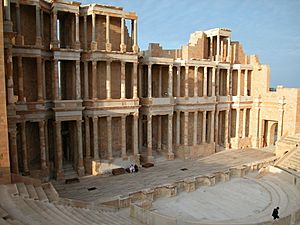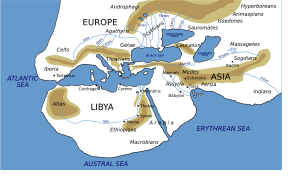Ancient Libya facts for kids
The Latin name Libya came from the Greek word Libyē. It was used to describe the large region west of the Nile River. This area is similar to what we now call the Maghreb in North Africa. The people who lived there were the ancestors of today's Berbers. Berbers lived in this region for thousands of years, even before ancient Egypt started keeping written records. Changes in the climate affected where these early people settled.
Sometimes, Libya referred more specifically to the land right next to Egypt on its west side. This included areas like Marmarica and Cyrenaica. The Libyan Sea was the part of the Mediterranean Sea south of Crete, located between the cities of Cyrene and Alexandria.
During the Hellenistic period (when Greek culture was very important), the Berbers were known as Libyans. This was a Greek name for the people living in the Maghreb region. Their lands were called "Libya" and stretched from modern Morocco all the way to the western borders of ancient Egypt. Today, the Siwa Oasis in modern Egypt was once part of ancient Libya. A Berber language called Siwi is still spoken there today.
Contents
Exploring Ancient Libya's Past
Historians don't know as much about the history of ancient Libya compared to the history of Egypt. This is because there are not many written records left from that time. What we do know about ancient Libya comes from studying archaeological sites (like old ruins and artifacts). We also learn from historical writings by their neighbors, such as the ancient Egyptians, Greeks, Romans, Byzantines, and later, Arabs from the Middle Ages.
Over thousands of years, the climate in North Africa became much drier. This process is called desertification. We can still see reminders of this change today. There are many huge stone structures, called megaliths, found in areas that are now dry and empty. These include dolmens (stone tables), stone circles (like Stonehenge), cairns (piles of stones), and even structures that look like small step-pyramids. Some of the most amazing are the trilithons, which are three large stones forming a gateway. These ancient structures show that people once lived in these now-desert areas.
Throughout ancient times, different powerful groups ruled over parts of Libya. These included the Phoenicians and Carthaginians, the Persian Achaemenid Empire, the armies of Alexander the Great and his Ptolemaic successors from Egypt. Later, the Romans, Vandals, and local rulers from the Byzantine Empire also controlled these lands. The areas that make up modern Libya had separate histories until Roman times, especially the regions of Tripoli and Cyrenaica.
Cyrenaica, for example, was a Greek region before it became Roman. It was also known as Pentapolis, which means "five cities." These five important cities were Cyrene (with its port of Apollonia), Arsinoe, Berenice, and Barca. The fertile coastal plain of this region got its name, Cyrenaica, from Cyrene, the oldest and most famous of these Greek colonies.
Understanding Ancient Libya's Borders
The exact borders of ancient Libya are not fully known. It was located west of Ancient Egypt and was called "Tjehenu" by the ancient Egyptians. To the Egyptians, Libya was a mysterious land, sometimes even seen as the land of spirits.
To the Ancient Greeks, Libya was considered one of the three known continents, along with Asia and Europe. In this sense, Libya meant the entire known African continent west of the Nile Valley, extending south of Egypt. The Greek historian Herodotus described the people of Libya as two main groups: the Libyans in northern Africa and the Ethiopians in the south. According to Herodotus, Libya began where Ancient Egypt ended and stretched all the way to Cape Spartel, which is south of Tangier on the Atlantic coast.
Modern geographers believe that the ancient Libyans might have seen their forests disappear, their fresh water sources dry up, and their hunting grounds shrink as the area slowly turned into a desert.
The People of Ancient Libya
There were many Berber tribes living in ancient Libya. Some, like the Psylli, are now extinct. The Libu tribe was one of the most well-known. Most ancient Libyans were nomadic pastoralists. This means they moved around with their herds of goats, sheep, and other animals. They used their livestock for food (milk and meat), and for materials like hides and wool to make tents and clothing.
Ancient Egyptian records describe Libyan men with long hair, often braided and decorated with beads. They would part their hair neatly and wear feathers attached to leather bands around their heads. They wore thin robes made of antelope hide, which were dyed and printed, crossing one shoulder and reaching to mid-calf. Older men often had long, braided beards. Women wore similar robes to men, with braided and decorated hair, and both genders wore heavy jewelry. Their weapons included bows and arrows, hatchets, spears, and daggers.
The ancient Libyan script, or writing system, was mainly used for funerary purposes, like on tombs. It is quite difficult to understand, and there were several different versions of it.
The historian Ibn Khaldun later divided the Berbers into two main groups: the Batr and the Baranis.
Herodotus also divided the Libyans into Eastern Libyans and Western Libyans. The Eastern Libyans were nomadic shepherds who lived east of Lake Tritonis. The Western Libyans were farmers who lived west of Lake Tritonis. At some point, a big change happened, and the large freshwater Lake Tritonis became a seasonal lake or marsh.
See also
 In Spanish: Antigua Libia para niños
In Spanish: Antigua Libia para niños
Images for kids



